EML302 Assessment One: Oral Language Analysis and Newsletter
VerifiedAdded on 2023/06/10
|10
|2665
|52
AI Summary
This paper discusses the oral language development of a 3-year-old child named MJ with two supported oral language samples. It analyzes the components of oral language and the functions for which the child is using language. It also provides a newsletter for parents with tips on proper teaching methods for home.
Contribute Materials
Your contribution can guide someone’s learning journey. Share your
documents today.
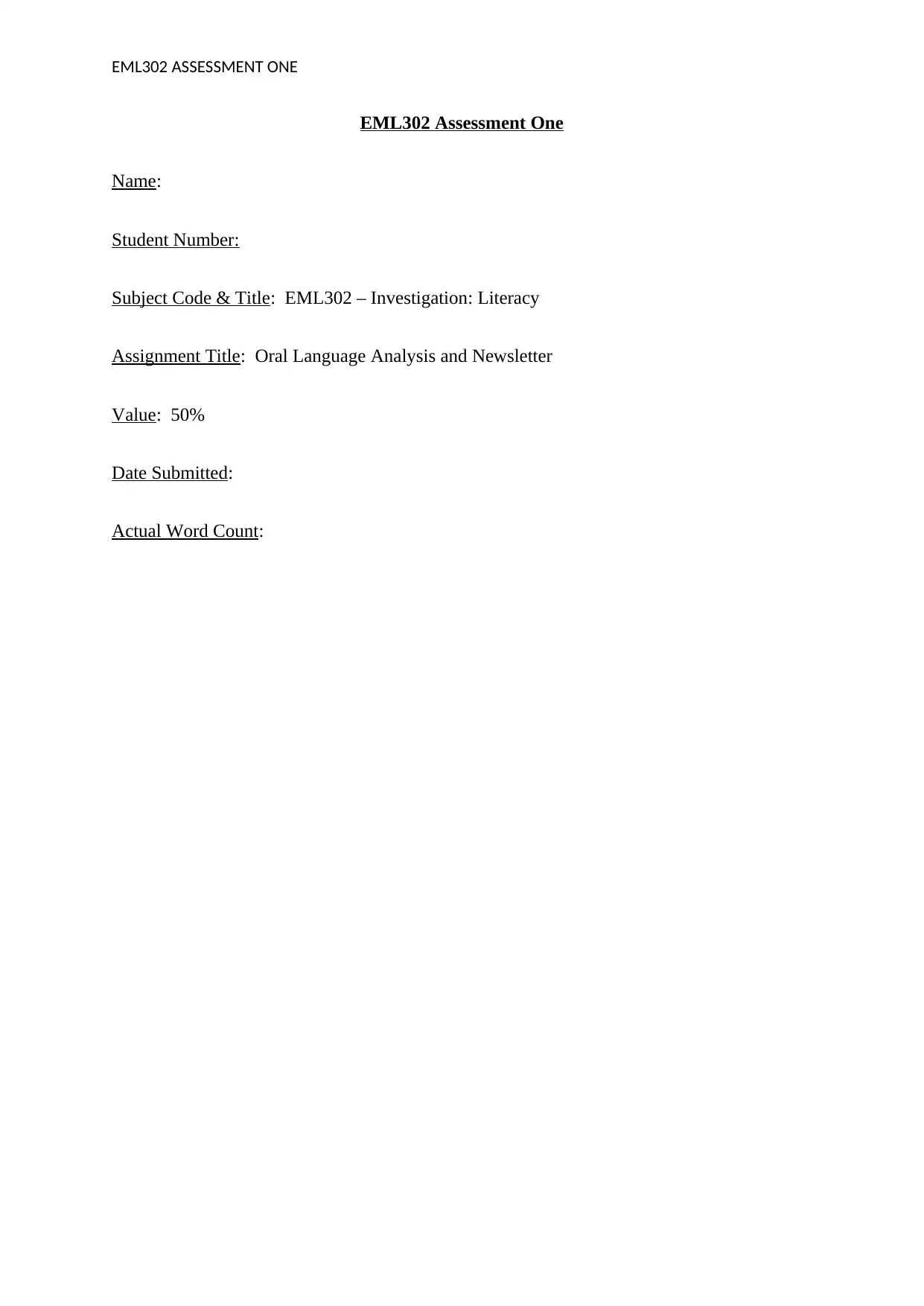
EML302 ASSESSMENT ONE
EML302 Assessment One
Name:
Student Number:
Subject Code & Title: EML302 – Investigation: Literacy
Assignment Title: Oral Language Analysis and Newsletter
Value: 50%
Date Submitted:
Actual Word Count:
EML302 Assessment One
Name:
Student Number:
Subject Code & Title: EML302 – Investigation: Literacy
Assignment Title: Oral Language Analysis and Newsletter
Value: 50%
Date Submitted:
Actual Word Count:
Secure Best Marks with AI Grader
Need help grading? Try our AI Grader for instant feedback on your assignments.
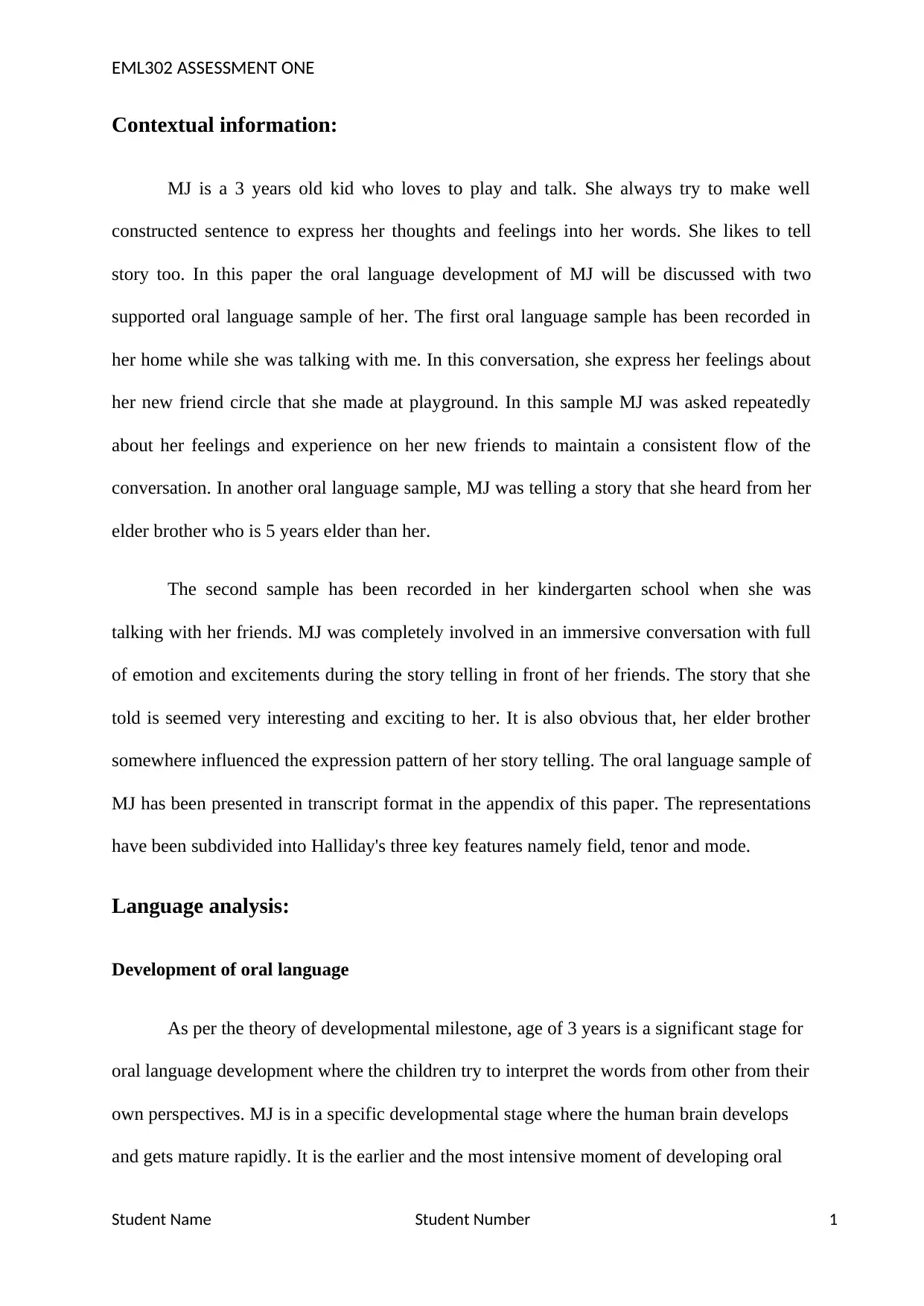
EML302 ASSESSMENT ONE
Contextual information:
MJ is a 3 years old kid who loves to play and talk. She always try to make well
constructed sentence to express her thoughts and feelings into her words. She likes to tell
story too. In this paper the oral language development of MJ will be discussed with two
supported oral language sample of her. The first oral language sample has been recorded in
her home while she was talking with me. In this conversation, she express her feelings about
her new friend circle that she made at playground. In this sample MJ was asked repeatedly
about her feelings and experience on her new friends to maintain a consistent flow of the
conversation. In another oral language sample, MJ was telling a story that she heard from her
elder brother who is 5 years elder than her.
The second sample has been recorded in her kindergarten school when she was
talking with her friends. MJ was completely involved in an immersive conversation with full
of emotion and excitements during the story telling in front of her friends. The story that she
told is seemed very interesting and exciting to her. It is also obvious that, her elder brother
somewhere influenced the expression pattern of her story telling. The oral language sample of
MJ has been presented in transcript format in the appendix of this paper. The representations
have been subdivided into Halliday's three key features namely field, tenor and mode.
Language analysis:
Development of oral language
As per the theory of developmental milestone, age of 3 years is a significant stage for
oral language development where the children try to interpret the words from other from their
own perspectives. MJ is in a specific developmental stage where the human brain develops
and gets mature rapidly. It is the earlier and the most intensive moment of developing oral
Student Name Student Number 1
Contextual information:
MJ is a 3 years old kid who loves to play and talk. She always try to make well
constructed sentence to express her thoughts and feelings into her words. She likes to tell
story too. In this paper the oral language development of MJ will be discussed with two
supported oral language sample of her. The first oral language sample has been recorded in
her home while she was talking with me. In this conversation, she express her feelings about
her new friend circle that she made at playground. In this sample MJ was asked repeatedly
about her feelings and experience on her new friends to maintain a consistent flow of the
conversation. In another oral language sample, MJ was telling a story that she heard from her
elder brother who is 5 years elder than her.
The second sample has been recorded in her kindergarten school when she was
talking with her friends. MJ was completely involved in an immersive conversation with full
of emotion and excitements during the story telling in front of her friends. The story that she
told is seemed very interesting and exciting to her. It is also obvious that, her elder brother
somewhere influenced the expression pattern of her story telling. The oral language sample of
MJ has been presented in transcript format in the appendix of this paper. The representations
have been subdivided into Halliday's three key features namely field, tenor and mode.
Language analysis:
Development of oral language
As per the theory of developmental milestone, age of 3 years is a significant stage for
oral language development where the children try to interpret the words from other from their
own perspectives. MJ is in a specific developmental stage where the human brain develops
and gets mature rapidly. It is the earlier and the most intensive moment of developing oral
Student Name Student Number 1
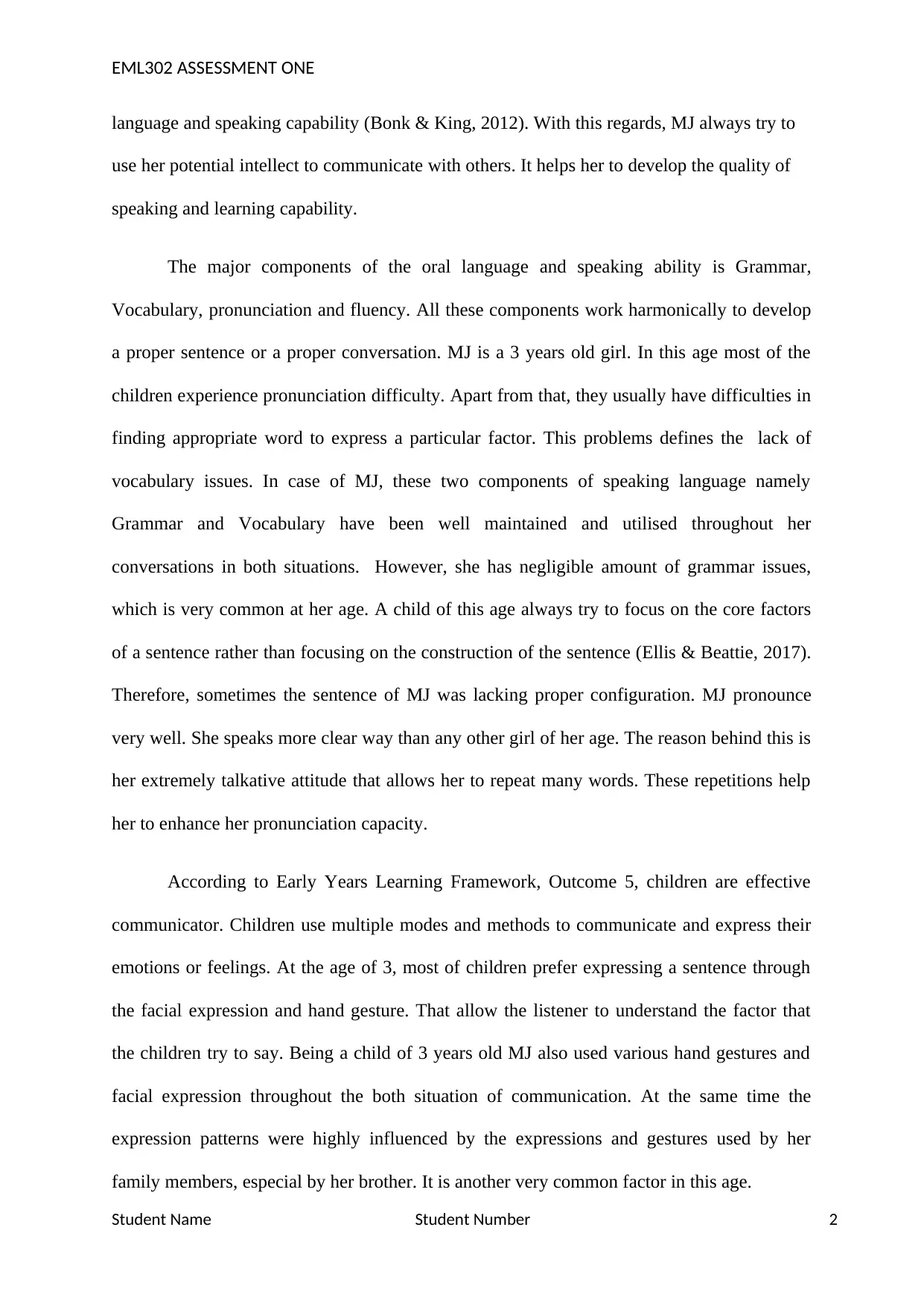
EML302 ASSESSMENT ONE
language and speaking capability (Bonk & King, 2012). With this regards, MJ always try to
use her potential intellect to communicate with others. It helps her to develop the quality of
speaking and learning capability.
The major components of the oral language and speaking ability is Grammar,
Vocabulary, pronunciation and fluency. All these components work harmonically to develop
a proper sentence or a proper conversation. MJ is a 3 years old girl. In this age most of the
children experience pronunciation difficulty. Apart from that, they usually have difficulties in
finding appropriate word to express a particular factor. This problems defines the lack of
vocabulary issues. In case of MJ, these two components of speaking language namely
Grammar and Vocabulary have been well maintained and utilised throughout her
conversations in both situations. However, she has negligible amount of grammar issues,
which is very common at her age. A child of this age always try to focus on the core factors
of a sentence rather than focusing on the construction of the sentence (Ellis & Beattie, 2017).
Therefore, sometimes the sentence of MJ was lacking proper configuration. MJ pronounce
very well. She speaks more clear way than any other girl of her age. The reason behind this is
her extremely talkative attitude that allows her to repeat many words. These repetitions help
her to enhance her pronunciation capacity.
According to Early Years Learning Framework, Outcome 5, children are effective
communicator. Children use multiple modes and methods to communicate and express their
emotions or feelings. At the age of 3, most of children prefer expressing a sentence through
the facial expression and hand gesture. That allow the listener to understand the factor that
the children try to say. Being a child of 3 years old MJ also used various hand gestures and
facial expression throughout the both situation of communication. At the same time the
expression patterns were highly influenced by the expressions and gestures used by her
family members, especial by her brother. It is another very common factor in this age.
Student Name Student Number 2
language and speaking capability (Bonk & King, 2012). With this regards, MJ always try to
use her potential intellect to communicate with others. It helps her to develop the quality of
speaking and learning capability.
The major components of the oral language and speaking ability is Grammar,
Vocabulary, pronunciation and fluency. All these components work harmonically to develop
a proper sentence or a proper conversation. MJ is a 3 years old girl. In this age most of the
children experience pronunciation difficulty. Apart from that, they usually have difficulties in
finding appropriate word to express a particular factor. This problems defines the lack of
vocabulary issues. In case of MJ, these two components of speaking language namely
Grammar and Vocabulary have been well maintained and utilised throughout her
conversations in both situations. However, she has negligible amount of grammar issues,
which is very common at her age. A child of this age always try to focus on the core factors
of a sentence rather than focusing on the construction of the sentence (Ellis & Beattie, 2017).
Therefore, sometimes the sentence of MJ was lacking proper configuration. MJ pronounce
very well. She speaks more clear way than any other girl of her age. The reason behind this is
her extremely talkative attitude that allows her to repeat many words. These repetitions help
her to enhance her pronunciation capacity.
According to Early Years Learning Framework, Outcome 5, children are effective
communicator. Children use multiple modes and methods to communicate and express their
emotions or feelings. At the age of 3, most of children prefer expressing a sentence through
the facial expression and hand gesture. That allow the listener to understand the factor that
the children try to say. Being a child of 3 years old MJ also used various hand gestures and
facial expression throughout the both situation of communication. At the same time the
expression patterns were highly influenced by the expressions and gestures used by her
family members, especial by her brother. It is another very common factor in this age.
Student Name Student Number 2
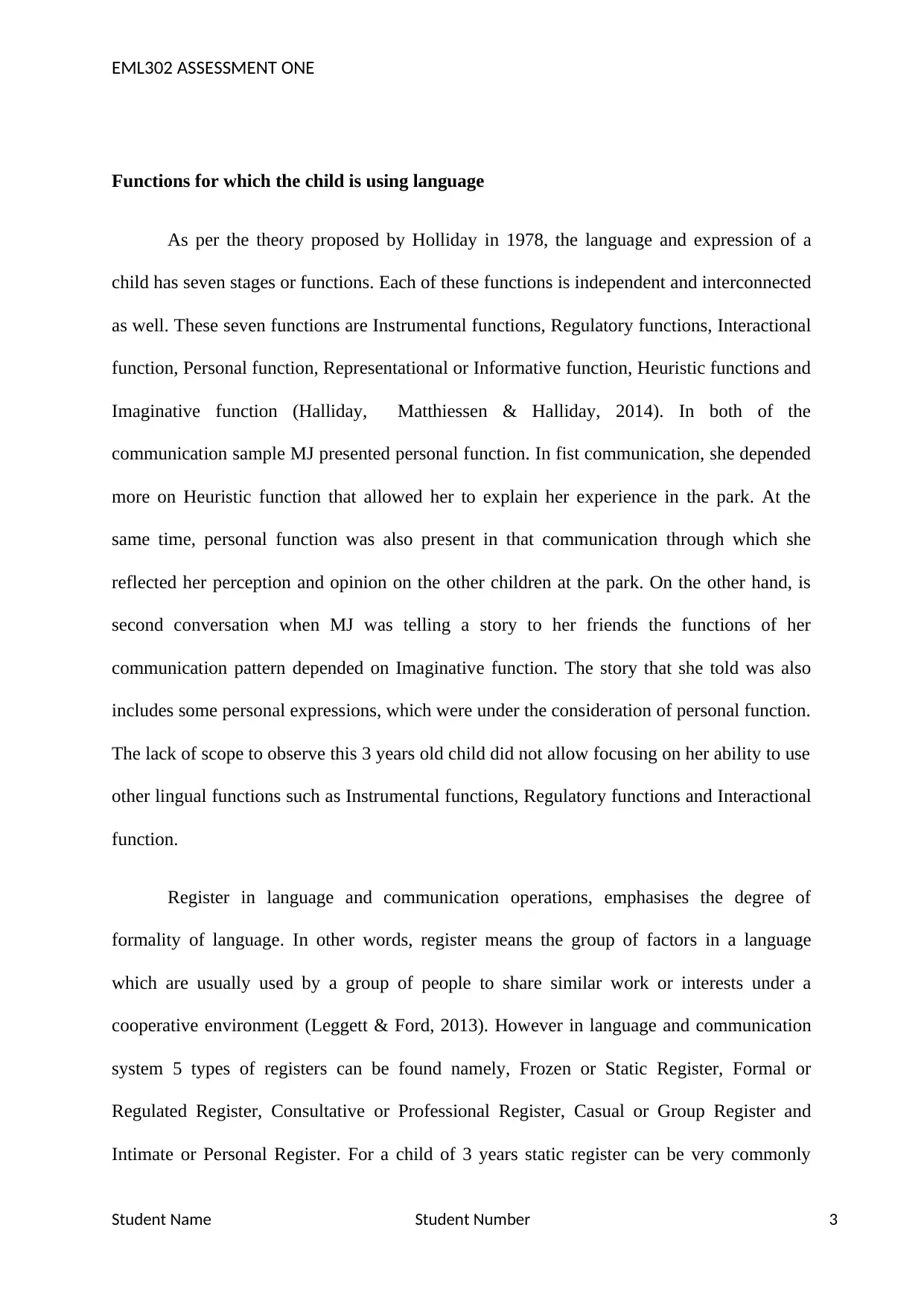
EML302 ASSESSMENT ONE
Functions for which the child is using language
As per the theory proposed by Holliday in 1978, the language and expression of a
child has seven stages or functions. Each of these functions is independent and interconnected
as well. These seven functions are Instrumental functions, Regulatory functions, Interactional
function, Personal function, Representational or Informative function, Heuristic functions and
Imaginative function (Halliday, Matthiessen & Halliday, 2014). In both of the
communication sample MJ presented personal function. In fist communication, she depended
more on Heuristic function that allowed her to explain her experience in the park. At the
same time, personal function was also present in that communication through which she
reflected her perception and opinion on the other children at the park. On the other hand, is
second conversation when MJ was telling a story to her friends the functions of her
communication pattern depended on Imaginative function. The story that she told was also
includes some personal expressions, which were under the consideration of personal function.
The lack of scope to observe this 3 years old child did not allow focusing on her ability to use
other lingual functions such as Instrumental functions, Regulatory functions and Interactional
function.
Register in language and communication operations, emphasises the degree of
formality of language. In other words, register means the group of factors in a language
which are usually used by a group of people to share similar work or interests under a
cooperative environment (Leggett & Ford, 2013). However in language and communication
system 5 types of registers can be found namely, Frozen or Static Register, Formal or
Regulated Register, Consultative or Professional Register, Casual or Group Register and
Intimate or Personal Register. For a child of 3 years static register can be very commonly
Student Name Student Number 3
Functions for which the child is using language
As per the theory proposed by Holliday in 1978, the language and expression of a
child has seven stages or functions. Each of these functions is independent and interconnected
as well. These seven functions are Instrumental functions, Regulatory functions, Interactional
function, Personal function, Representational or Informative function, Heuristic functions and
Imaginative function (Halliday, Matthiessen & Halliday, 2014). In both of the
communication sample MJ presented personal function. In fist communication, she depended
more on Heuristic function that allowed her to explain her experience in the park. At the
same time, personal function was also present in that communication through which she
reflected her perception and opinion on the other children at the park. On the other hand, is
second conversation when MJ was telling a story to her friends the functions of her
communication pattern depended on Imaginative function. The story that she told was also
includes some personal expressions, which were under the consideration of personal function.
The lack of scope to observe this 3 years old child did not allow focusing on her ability to use
other lingual functions such as Instrumental functions, Regulatory functions and Interactional
function.
Register in language and communication operations, emphasises the degree of
formality of language. In other words, register means the group of factors in a language
which are usually used by a group of people to share similar work or interests under a
cooperative environment (Leggett & Ford, 2013). However in language and communication
system 5 types of registers can be found namely, Frozen or Static Register, Formal or
Regulated Register, Consultative or Professional Register, Casual or Group Register and
Intimate or Personal Register. For a child of 3 years static register can be very commonly
Student Name Student Number 3
Secure Best Marks with AI Grader
Need help grading? Try our AI Grader for instant feedback on your assignments.
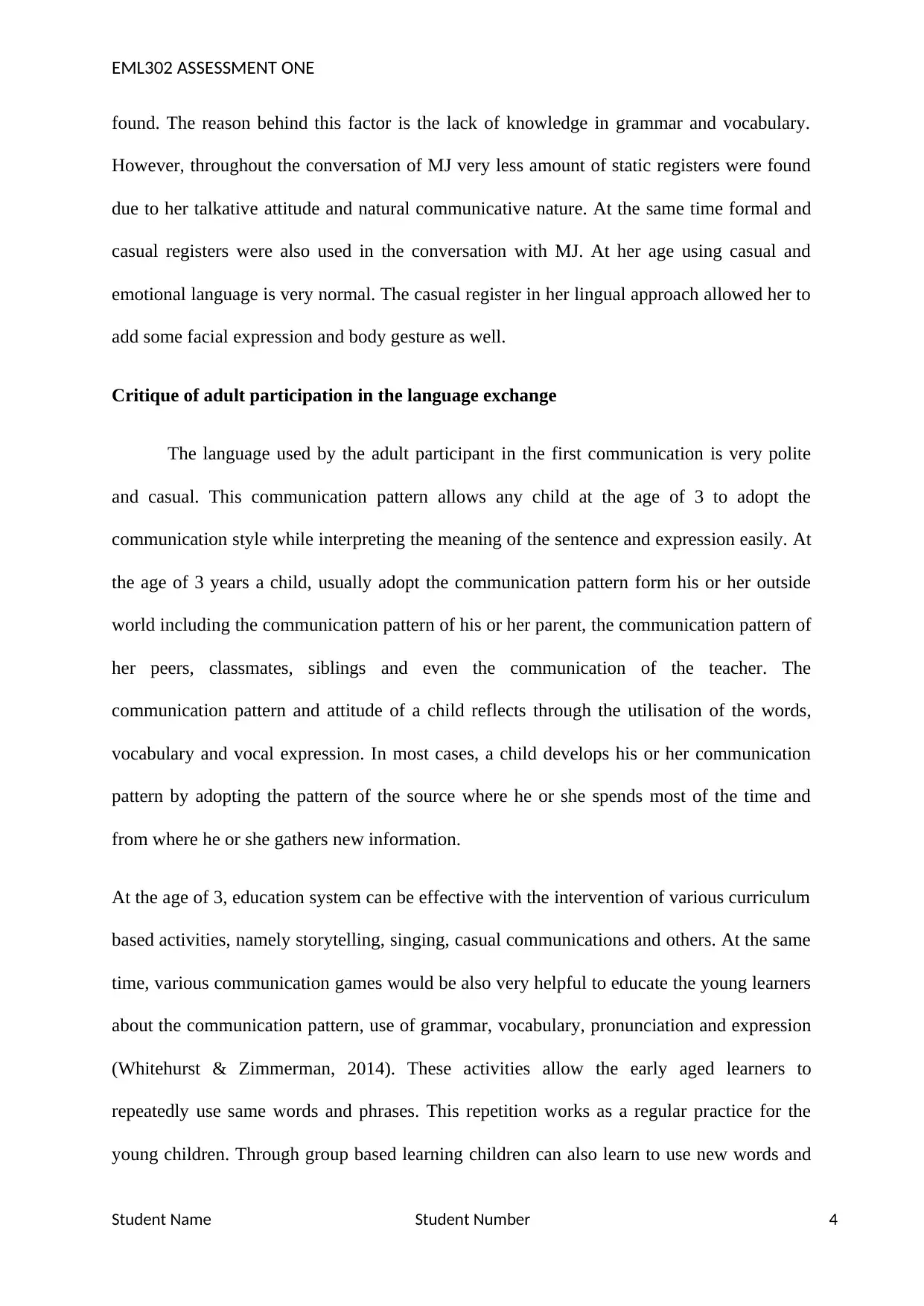
EML302 ASSESSMENT ONE
found. The reason behind this factor is the lack of knowledge in grammar and vocabulary.
However, throughout the conversation of MJ very less amount of static registers were found
due to her talkative attitude and natural communicative nature. At the same time formal and
casual registers were also used in the conversation with MJ. At her age using casual and
emotional language is very normal. The casual register in her lingual approach allowed her to
add some facial expression and body gesture as well.
Critique of adult participation in the language exchange
The language used by the adult participant in the first communication is very polite
and casual. This communication pattern allows any child at the age of 3 to adopt the
communication style while interpreting the meaning of the sentence and expression easily. At
the age of 3 years a child, usually adopt the communication pattern form his or her outside
world including the communication pattern of his or her parent, the communication pattern of
her peers, classmates, siblings and even the communication of the teacher. The
communication pattern and attitude of a child reflects through the utilisation of the words,
vocabulary and vocal expression. In most cases, a child develops his or her communication
pattern by adopting the pattern of the source where he or she spends most of the time and
from where he or she gathers new information.
At the age of 3, education system can be effective with the intervention of various curriculum
based activities, namely storytelling, singing, casual communications and others. At the same
time, various communication games would be also very helpful to educate the young learners
about the communication pattern, use of grammar, vocabulary, pronunciation and expression
(Whitehurst & Zimmerman, 2014). These activities allow the early aged learners to
repeatedly use same words and phrases. This repetition works as a regular practice for the
young children. Through group based learning children can also learn to use new words and
Student Name Student Number 4
found. The reason behind this factor is the lack of knowledge in grammar and vocabulary.
However, throughout the conversation of MJ very less amount of static registers were found
due to her talkative attitude and natural communicative nature. At the same time formal and
casual registers were also used in the conversation with MJ. At her age using casual and
emotional language is very normal. The casual register in her lingual approach allowed her to
add some facial expression and body gesture as well.
Critique of adult participation in the language exchange
The language used by the adult participant in the first communication is very polite
and casual. This communication pattern allows any child at the age of 3 to adopt the
communication style while interpreting the meaning of the sentence and expression easily. At
the age of 3 years a child, usually adopt the communication pattern form his or her outside
world including the communication pattern of his or her parent, the communication pattern of
her peers, classmates, siblings and even the communication of the teacher. The
communication pattern and attitude of a child reflects through the utilisation of the words,
vocabulary and vocal expression. In most cases, a child develops his or her communication
pattern by adopting the pattern of the source where he or she spends most of the time and
from where he or she gathers new information.
At the age of 3, education system can be effective with the intervention of various curriculum
based activities, namely storytelling, singing, casual communications and others. At the same
time, various communication games would be also very helpful to educate the young learners
about the communication pattern, use of grammar, vocabulary, pronunciation and expression
(Whitehurst & Zimmerman, 2014). These activities allow the early aged learners to
repeatedly use same words and phrases. This repetition works as a regular practice for the
young children. Through group based learning children can also learn to use new words and
Student Name Student Number 4
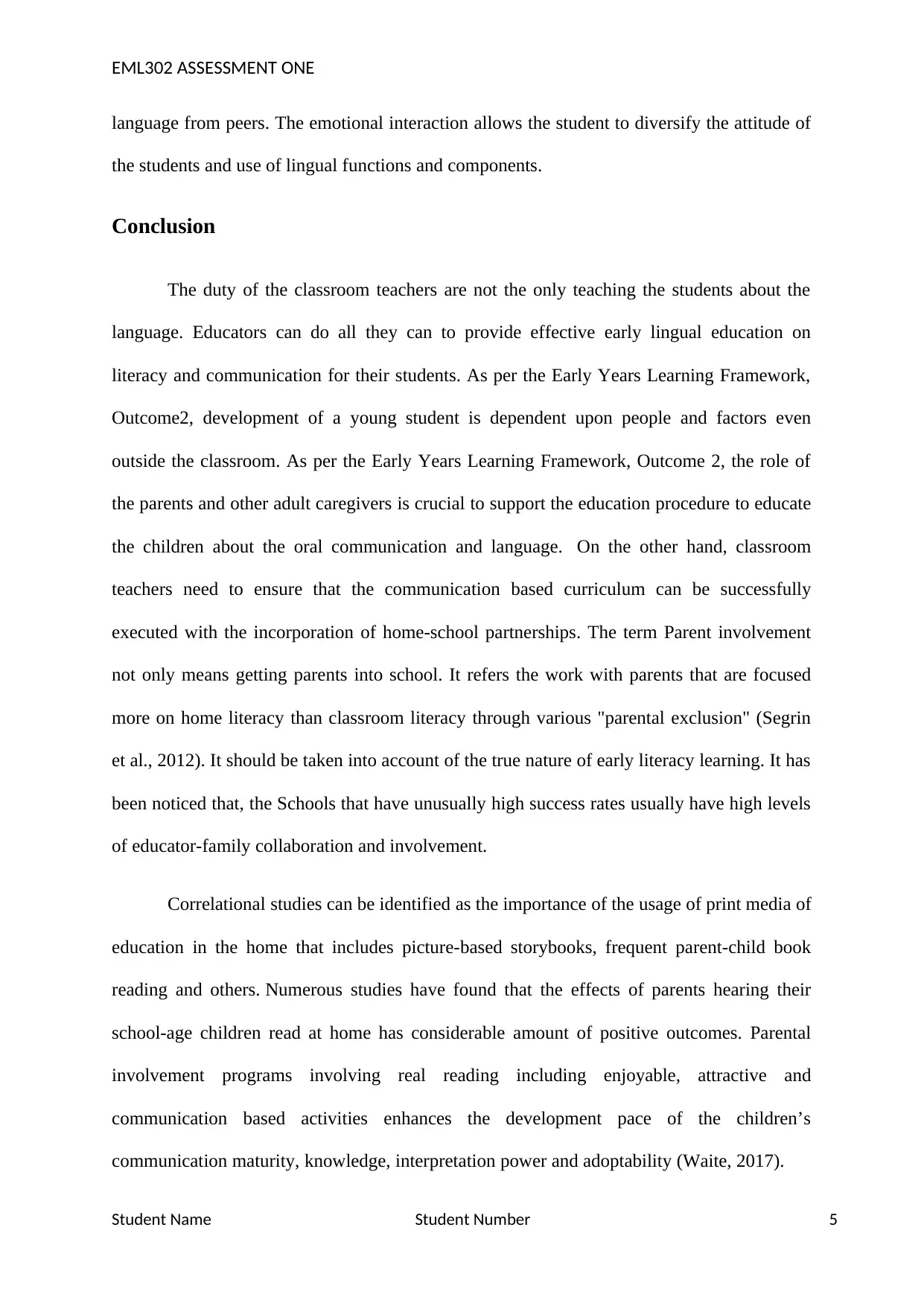
EML302 ASSESSMENT ONE
language from peers. The emotional interaction allows the student to diversify the attitude of
the students and use of lingual functions and components.
Conclusion
The duty of the classroom teachers are not the only teaching the students about the
language. Educators can do all they can to provide effective early lingual education on
literacy and communication for their students. As per the Early Years Learning Framework,
Outcome2, development of a young student is dependent upon people and factors even
outside the classroom. As per the Early Years Learning Framework, Outcome 2, the role of
the parents and other adult caregivers is crucial to support the education procedure to educate
the children about the oral communication and language. On the other hand, classroom
teachers need to ensure that the communication based curriculum can be successfully
executed with the incorporation of home-school partnerships. The term Parent involvement
not only means getting parents into school. It refers the work with parents that are focused
more on home literacy than classroom literacy through various "parental exclusion" (Segrin
et al., 2012). It should be taken into account of the true nature of early literacy learning. It has
been noticed that, the Schools that have unusually high success rates usually have high levels
of educator-family collaboration and involvement.
Correlational studies can be identified as the importance of the usage of print media of
education in the home that includes picture-based storybooks, frequent parent-child book
reading and others. Numerous studies have found that the effects of parents hearing their
school-age children read at home has considerable amount of positive outcomes. Parental
involvement programs involving real reading including enjoyable, attractive and
communication based activities enhances the development pace of the children’s
communication maturity, knowledge, interpretation power and adoptability (Waite, 2017).
Student Name Student Number 5
language from peers. The emotional interaction allows the student to diversify the attitude of
the students and use of lingual functions and components.
Conclusion
The duty of the classroom teachers are not the only teaching the students about the
language. Educators can do all they can to provide effective early lingual education on
literacy and communication for their students. As per the Early Years Learning Framework,
Outcome2, development of a young student is dependent upon people and factors even
outside the classroom. As per the Early Years Learning Framework, Outcome 2, the role of
the parents and other adult caregivers is crucial to support the education procedure to educate
the children about the oral communication and language. On the other hand, classroom
teachers need to ensure that the communication based curriculum can be successfully
executed with the incorporation of home-school partnerships. The term Parent involvement
not only means getting parents into school. It refers the work with parents that are focused
more on home literacy than classroom literacy through various "parental exclusion" (Segrin
et al., 2012). It should be taken into account of the true nature of early literacy learning. It has
been noticed that, the Schools that have unusually high success rates usually have high levels
of educator-family collaboration and involvement.
Correlational studies can be identified as the importance of the usage of print media of
education in the home that includes picture-based storybooks, frequent parent-child book
reading and others. Numerous studies have found that the effects of parents hearing their
school-age children read at home has considerable amount of positive outcomes. Parental
involvement programs involving real reading including enjoyable, attractive and
communication based activities enhances the development pace of the children’s
communication maturity, knowledge, interpretation power and adoptability (Waite, 2017).
Student Name Student Number 5
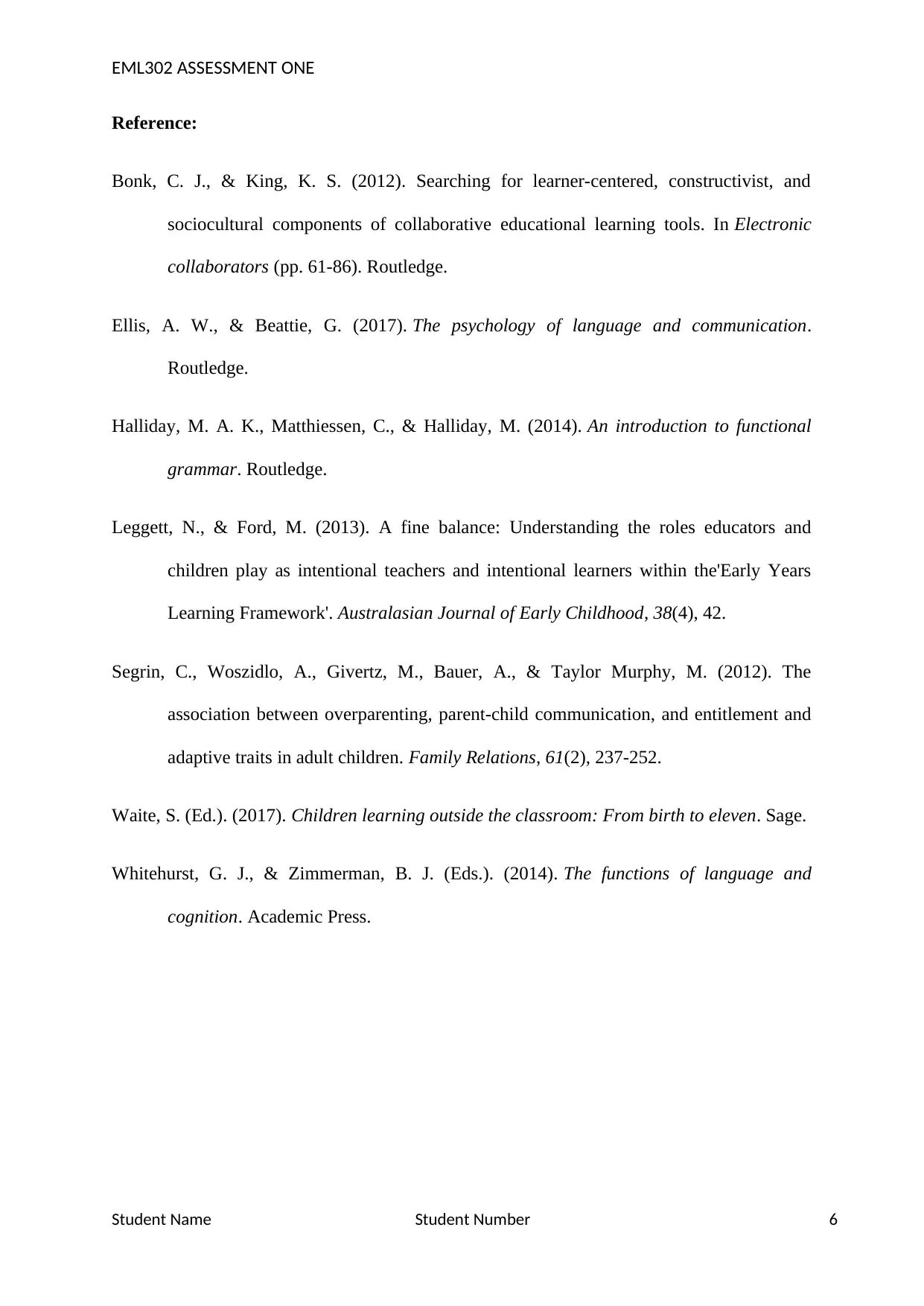
EML302 ASSESSMENT ONE
Reference:
Bonk, C. J., & King, K. S. (2012). Searching for learner-centered, constructivist, and
sociocultural components of collaborative educational learning tools. In Electronic
collaborators (pp. 61-86). Routledge.
Ellis, A. W., & Beattie, G. (2017). The psychology of language and communication.
Routledge.
Halliday, M. A. K., Matthiessen, C., & Halliday, M. (2014). An introduction to functional
grammar. Routledge.
Leggett, N., & Ford, M. (2013). A fine balance: Understanding the roles educators and
children play as intentional teachers and intentional learners within the'Early Years
Learning Framework'. Australasian Journal of Early Childhood, 38(4), 42.
Segrin, C., Woszidlo, A., Givertz, M., Bauer, A., & Taylor Murphy, M. (2012). The
association between overparenting, parent‐child communication, and entitlement and
adaptive traits in adult children. Family Relations, 61(2), 237-252.
Waite, S. (Ed.). (2017). Children learning outside the classroom: From birth to eleven. Sage.
Whitehurst, G. J., & Zimmerman, B. J. (Eds.). (2014). The functions of language and
cognition. Academic Press.
Student Name Student Number 6
Reference:
Bonk, C. J., & King, K. S. (2012). Searching for learner-centered, constructivist, and
sociocultural components of collaborative educational learning tools. In Electronic
collaborators (pp. 61-86). Routledge.
Ellis, A. W., & Beattie, G. (2017). The psychology of language and communication.
Routledge.
Halliday, M. A. K., Matthiessen, C., & Halliday, M. (2014). An introduction to functional
grammar. Routledge.
Leggett, N., & Ford, M. (2013). A fine balance: Understanding the roles educators and
children play as intentional teachers and intentional learners within the'Early Years
Learning Framework'. Australasian Journal of Early Childhood, 38(4), 42.
Segrin, C., Woszidlo, A., Givertz, M., Bauer, A., & Taylor Murphy, M. (2012). The
association between overparenting, parent‐child communication, and entitlement and
adaptive traits in adult children. Family Relations, 61(2), 237-252.
Waite, S. (Ed.). (2017). Children learning outside the classroom: From birth to eleven. Sage.
Whitehurst, G. J., & Zimmerman, B. J. (Eds.). (2014). The functions of language and
cognition. Academic Press.
Student Name Student Number 6
Paraphrase This Document
Need a fresh take? Get an instant paraphrase of this document with our AI Paraphraser
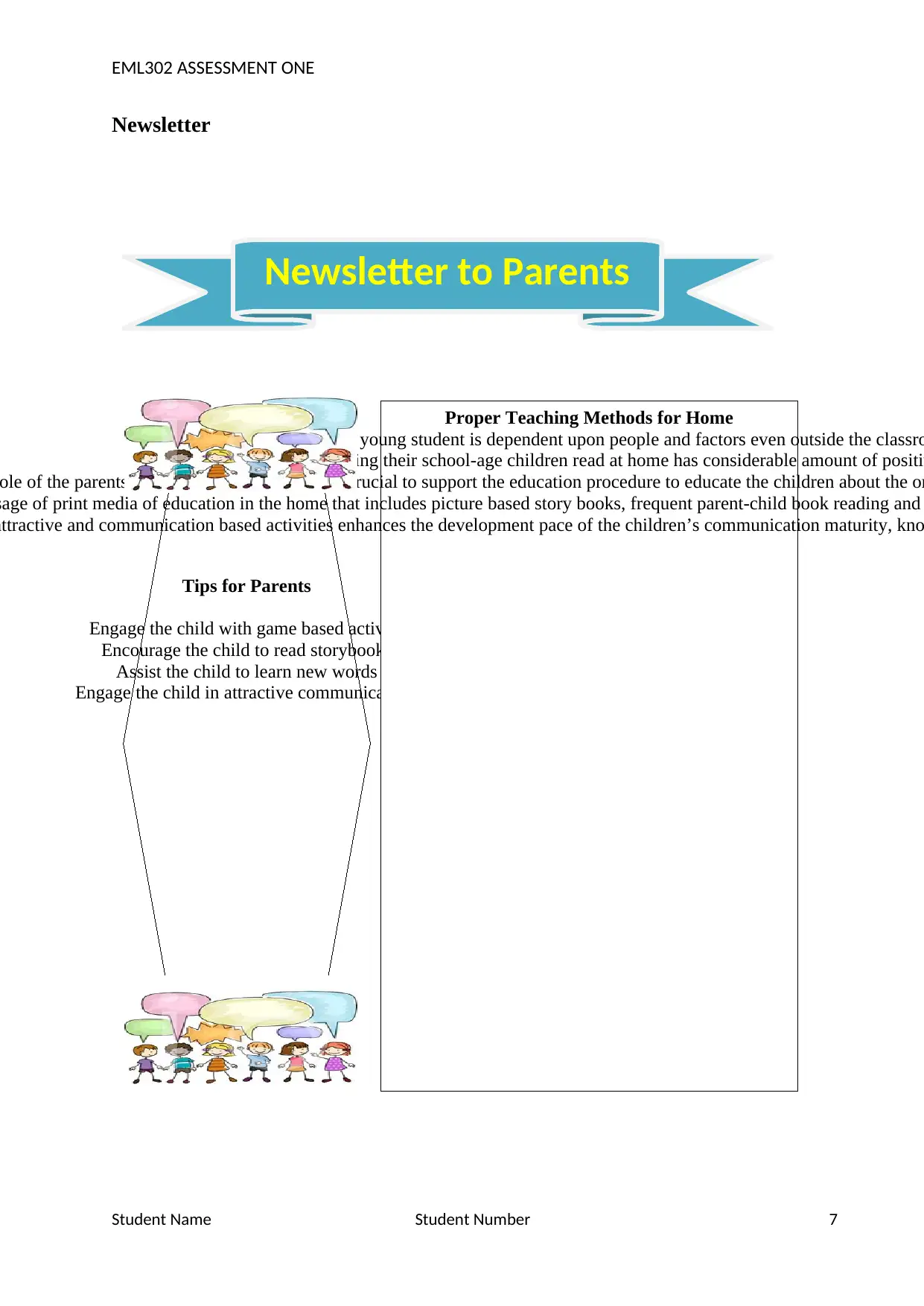
Newsletter to Parents
Tips for Parents
Engage the child with game based activity
Encourage the child to read storybooks
Assist the child to learn new words
Engage the child in attractive communication
Proper Teaching Methods for Home
Development of a young student is dependent upon people and factors even outside the classro
The effects of parents hearing their school-age children read at home has considerable amount of positi
ole of the parents and other adult caregivers is crucial to support the education procedure to educate the children about the or
sage of print media of education in the home that includes picture based story books, frequent parent-child book reading and
attractive and communication based activities enhances the development pace of the children’s communication maturity, kno
EML302 ASSESSMENT ONE
Newsletter
Student Name Student Number 7
Tips for Parents
Engage the child with game based activity
Encourage the child to read storybooks
Assist the child to learn new words
Engage the child in attractive communication
Proper Teaching Methods for Home
Development of a young student is dependent upon people and factors even outside the classro
The effects of parents hearing their school-age children read at home has considerable amount of positi
ole of the parents and other adult caregivers is crucial to support the education procedure to educate the children about the or
sage of print media of education in the home that includes picture based story books, frequent parent-child book reading and
attractive and communication based activities enhances the development pace of the children’s communication maturity, kno
EML302 ASSESSMENT ONE
Newsletter
Student Name Student Number 7
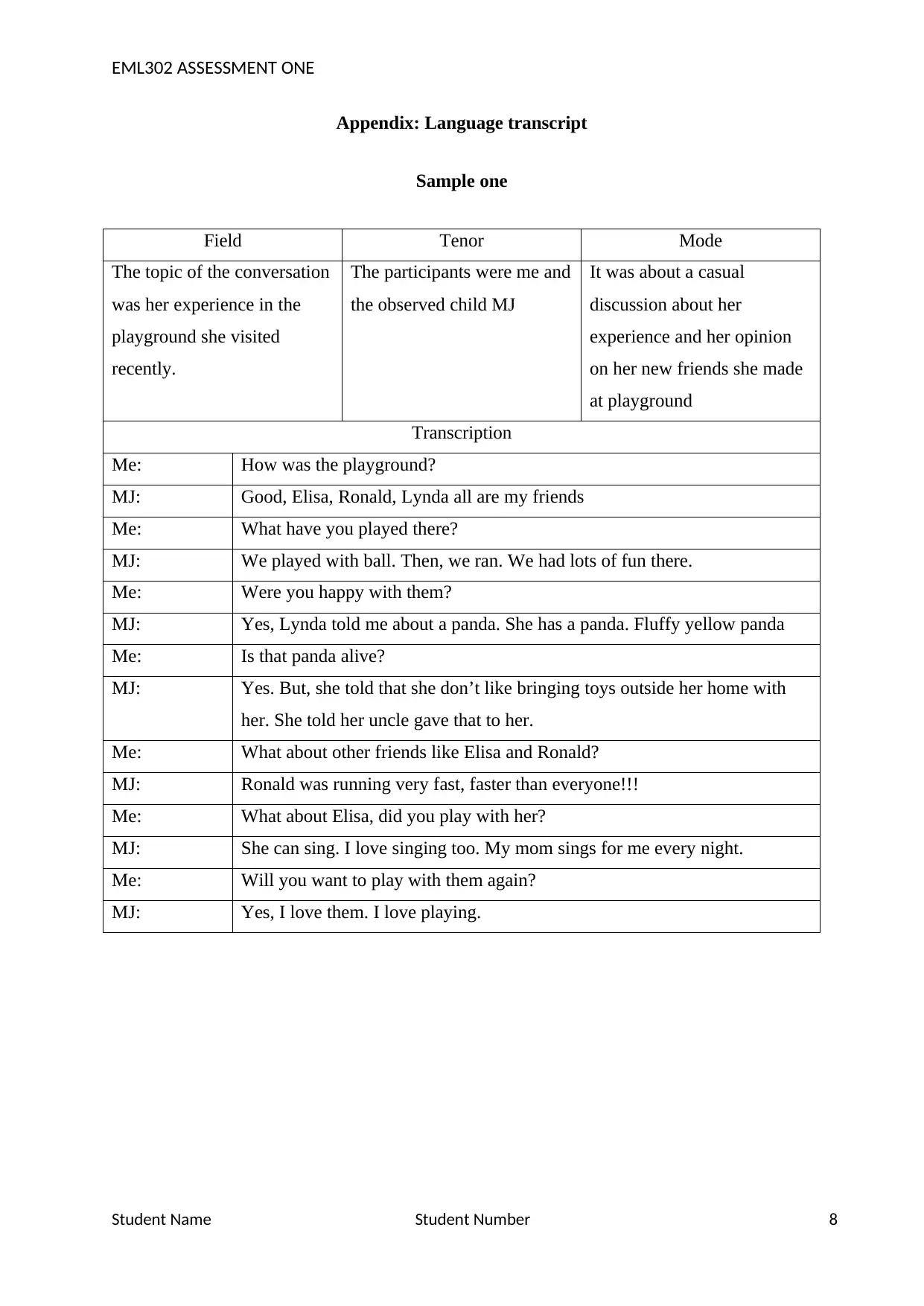
EML302 ASSESSMENT ONE
Appendix: Language transcript
Sample one
Field Tenor Mode
The topic of the conversation
was her experience in the
playground she visited
recently.
The participants were me and
the observed child MJ
It was about a casual
discussion about her
experience and her opinion
on her new friends she made
at playground
Transcription
Me: How was the playground?
MJ: Good, Elisa, Ronald, Lynda all are my friends
Me: What have you played there?
MJ: We played with ball. Then, we ran. We had lots of fun there.
Me: Were you happy with them?
MJ: Yes, Lynda told me about a panda. She has a panda. Fluffy yellow panda
Me: Is that panda alive?
MJ: Yes. But, she told that she don’t like bringing toys outside her home with
her. She told her uncle gave that to her.
Me: What about other friends like Elisa and Ronald?
MJ: Ronald was running very fast, faster than everyone!!!
Me: What about Elisa, did you play with her?
MJ: She can sing. I love singing too. My mom sings for me every night.
Me: Will you want to play with them again?
MJ: Yes, I love them. I love playing.
Student Name Student Number 8
Appendix: Language transcript
Sample one
Field Tenor Mode
The topic of the conversation
was her experience in the
playground she visited
recently.
The participants were me and
the observed child MJ
It was about a casual
discussion about her
experience and her opinion
on her new friends she made
at playground
Transcription
Me: How was the playground?
MJ: Good, Elisa, Ronald, Lynda all are my friends
Me: What have you played there?
MJ: We played with ball. Then, we ran. We had lots of fun there.
Me: Were you happy with them?
MJ: Yes, Lynda told me about a panda. She has a panda. Fluffy yellow panda
Me: Is that panda alive?
MJ: Yes. But, she told that she don’t like bringing toys outside her home with
her. She told her uncle gave that to her.
Me: What about other friends like Elisa and Ronald?
MJ: Ronald was running very fast, faster than everyone!!!
Me: What about Elisa, did you play with her?
MJ: She can sing. I love singing too. My mom sings for me every night.
Me: Will you want to play with them again?
MJ: Yes, I love them. I love playing.
Student Name Student Number 8
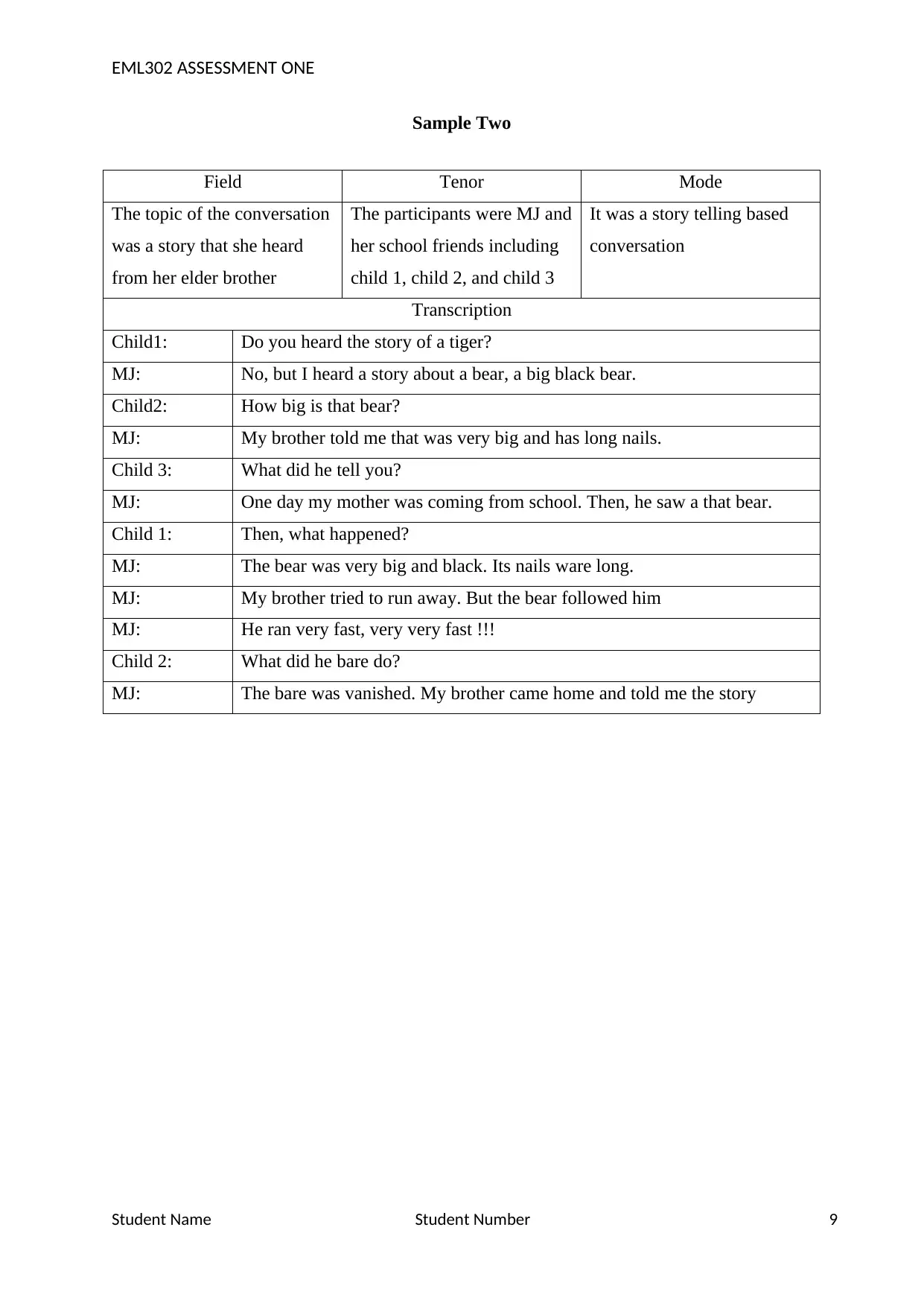
EML302 ASSESSMENT ONE
Sample Two
Field Tenor Mode
The topic of the conversation
was a story that she heard
from her elder brother
The participants were MJ and
her school friends including
child 1, child 2, and child 3
It was a story telling based
conversation
Transcription
Child1: Do you heard the story of a tiger?
MJ: No, but I heard a story about a bear, a big black bear.
Child2: How big is that bear?
MJ: My brother told me that was very big and has long nails.
Child 3: What did he tell you?
MJ: One day my mother was coming from school. Then, he saw a that bear.
Child 1: Then, what happened?
MJ: The bear was very big and black. Its nails ware long.
MJ: My brother tried to run away. But the bear followed him
MJ: He ran very fast, very very fast !!!
Child 2: What did he bare do?
MJ: The bare was vanished. My brother came home and told me the story
Student Name Student Number 9
Sample Two
Field Tenor Mode
The topic of the conversation
was a story that she heard
from her elder brother
The participants were MJ and
her school friends including
child 1, child 2, and child 3
It was a story telling based
conversation
Transcription
Child1: Do you heard the story of a tiger?
MJ: No, but I heard a story about a bear, a big black bear.
Child2: How big is that bear?
MJ: My brother told me that was very big and has long nails.
Child 3: What did he tell you?
MJ: One day my mother was coming from school. Then, he saw a that bear.
Child 1: Then, what happened?
MJ: The bear was very big and black. Its nails ware long.
MJ: My brother tried to run away. But the bear followed him
MJ: He ran very fast, very very fast !!!
Child 2: What did he bare do?
MJ: The bare was vanished. My brother came home and told me the story
Student Name Student Number 9
1 out of 10
Your All-in-One AI-Powered Toolkit for Academic Success.
+13062052269
info@desklib.com
Available 24*7 on WhatsApp / Email
![[object Object]](/_next/static/media/star-bottom.7253800d.svg)
Unlock your academic potential
© 2024 | Zucol Services PVT LTD | All rights reserved.



